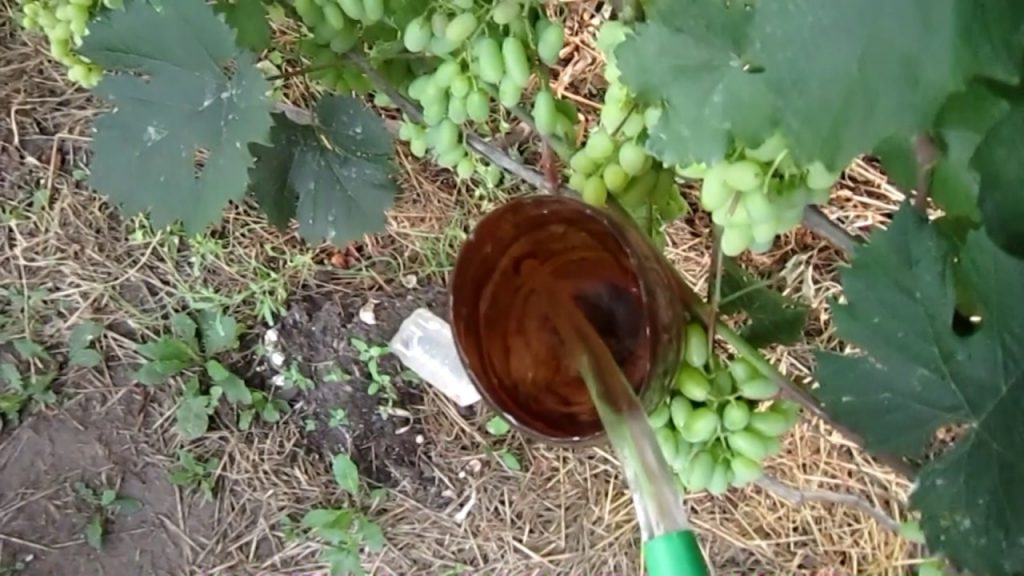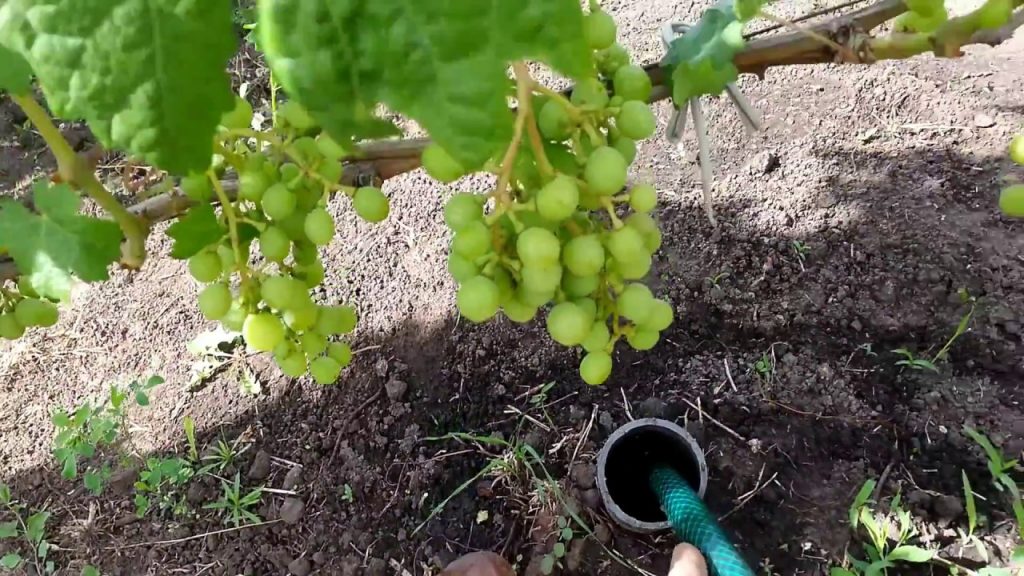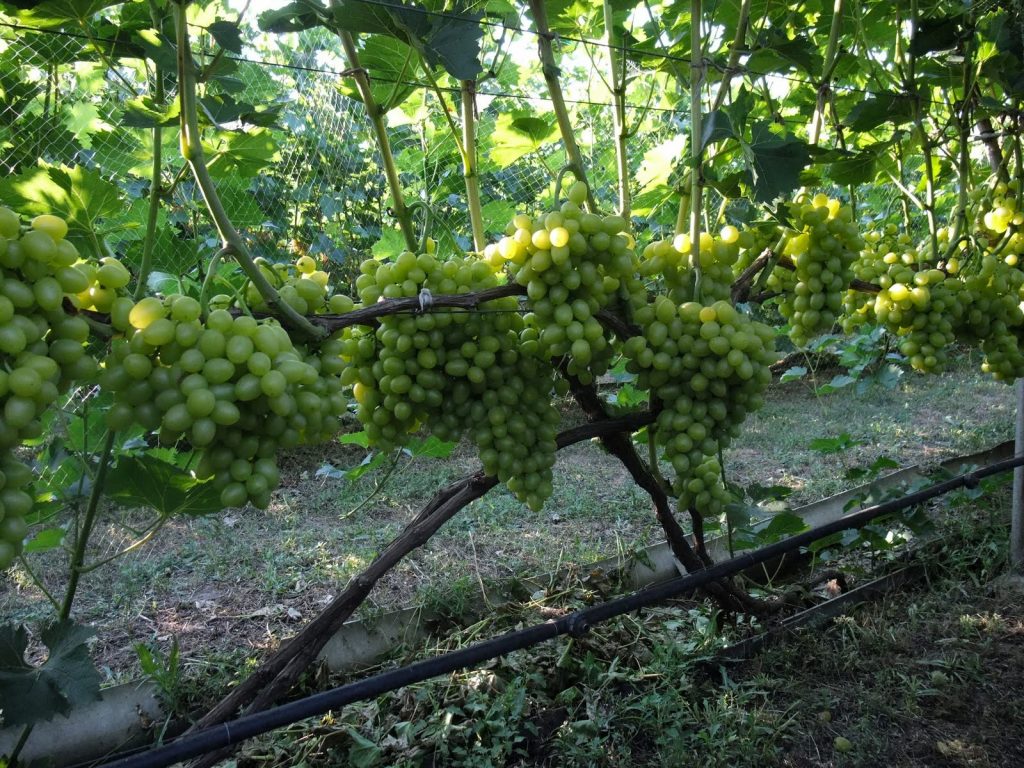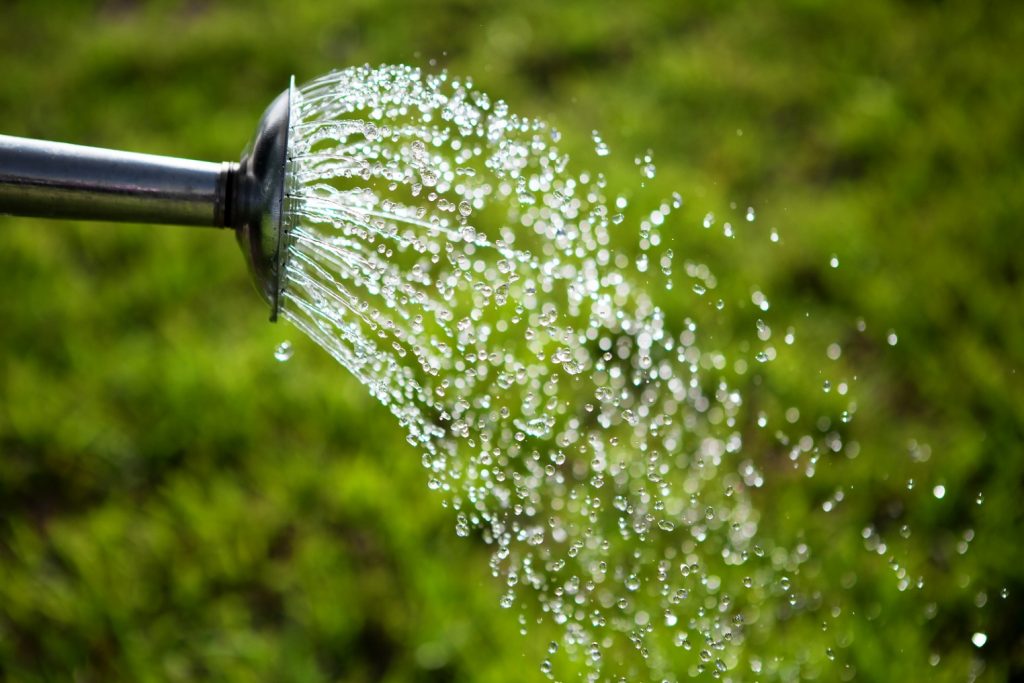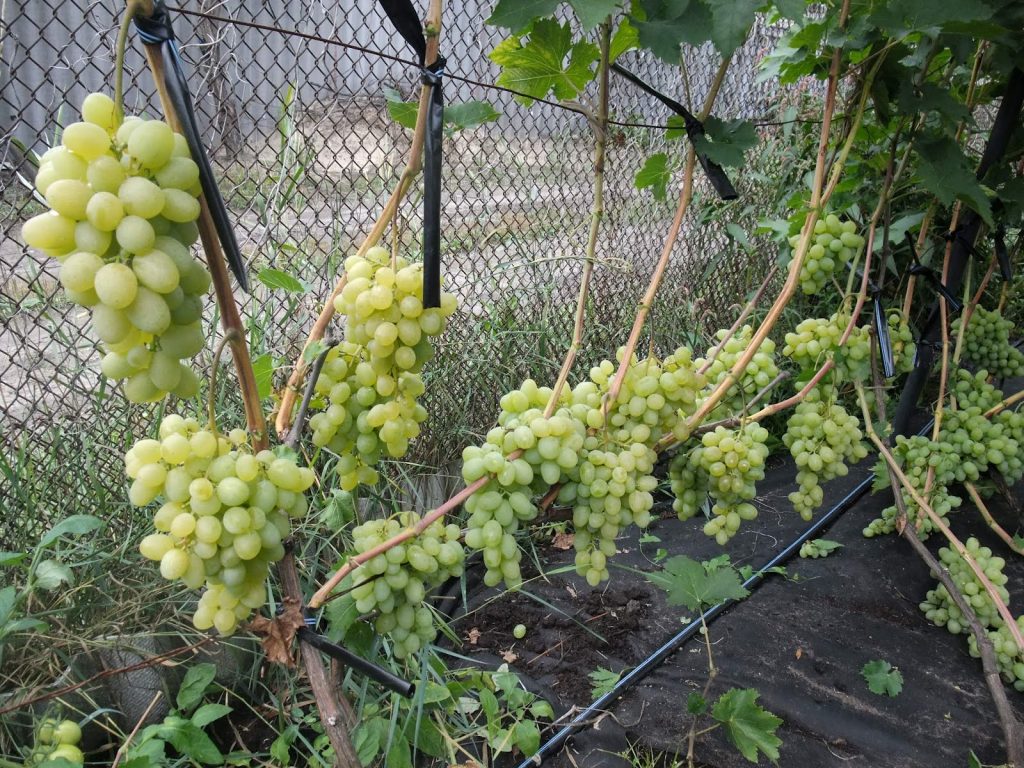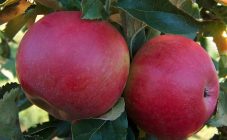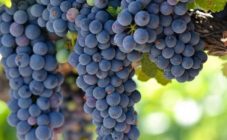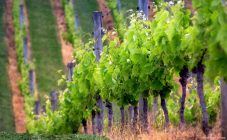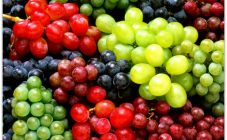Content:
Many gardeners grow grapes on their private plots, and every year there are more and more of them. Proper hydration of this crop ensures the health of the plant and its normal development. At various stages of grape growth, it is necessary to apply irrigation, based on certain norms, proportions and schedules. Each variety is watered differently. Irrigation, based on the right approach, guarantees a decent harvest of grapes for the summer resident.
Demanding grapes for moisture
If there is not enough moisture, the vine is subject to slower development and poor growth, and the shoots ripen extremely poorly. Also for this reason, a weakened grape bush can freeze in winter. Diseases and pests are much more likely to affect such a plant.
In the case when the moisture is more than required, the root system of the culture develops worse, and the grape shoots can continue to grow until the onset of winter, while the berries, as a rule, rot.
For the growth of a grape bush to be correct, it needs up to 700 mm of rainfall per year. This also includes rain, which is especially necessary and useful in the spring, when the plant has not yet bloomed, as well as towards the end of autumn, when the growing season is over. In winter, precipitation is also very necessary, and gardeners even contribute to the abundance of snow and its accumulation around the bushes so that the soil is well moistened during this period.
When it is located close to the surface of groundwater, the plant is less dependent on precipitation. It can fully develop and grow without them, but only if the waters are very close, up to 5 m.
Not the least role is played by air humidity, with a lack of which, the formation of organic matter by leaves and evaporation are much worse. Also, flowers are less pollinated. When the air humidity changes unexpectedly, it is very dangerous for the culture.
Depending on the season
Watering the grapes at different times of the year serves to achieve specific goals. To make it easier and more comfortable for the plant to endure the winter season, they take care of a sufficient set of moisture and water it in the fall. The same cumulative watering of grapes in spring and top dressing are necessary. In summer, it is important that the ground near the bush always remains moist.
Summer hydration for 1 year
After planting the seedlings, it is necessary that they take root, at this time the root system of a young plant especially needs a lot of water. In the first growing season, you need to carefully monitor the timely watering of the seedling.
A hole is made near each bush, or an ordinary plastic bottle with a notch is dropped in. This is done in order to be able to control, periodically adding water, the rate at which water is absorbed into the ground. After each irrigation done, this place is covered with dry soil to keep the soil moist longer.
Grapes, like many other plants, are best watered in the evening rather than during the day in sunlight. Before watering, the water is warmed up for a day and immediately before irrigation, groundbaits containing potassium, zinc and boron are added to it. It can also be chicken droppings or dung. Young bushes are watered at the rate of 15 liters per plant. Irrigation rates are applied later, by the end of summer.Time intervals are increased between them.
When ripe
Due to the high summer temperatures, the air humidity is greatly reduced; inside the culture, for the same reason, the temperature becomes high. The plant has a rapid evaporation, the metabolism is normalized only with irrigation at this time. Such watering is called vegetative.
In hot summer, watering is used to cool the plant. Irrigation ends when the bunches become varietal and distinctive.
How often to water the grapes? There are no clear rules for watering grapes. To determine them, it is necessary to take into account a certain number of factors, such as the region of cultivation, the peculiarities of the local temperature regime, the nature and condition of the soil, the number of sunny and warm days per year, as well as the distance to groundwater. Less moisture will be required for grapes if there is a predominance of black soil on the planting site. On lighter soils or sandy water, more is needed.
Abundant watering is used on very hot days, especially at a time when precipitation is not expected. Drought is a direct enemy for a full-fledged crop. Lack of humidity together with high temperatures often occurs in summer. Gardeners use options based on the difference in growing conditions:
- Several small holes are dug at each bush of the plant. Watering is done directly in them, but not for the culture itself;
- When the vines are intertwined or are at a close distance to each other, watering is applied using narrow recesses. Through such furrows in the ground, the culture receives the required volume of liquid much more;
- You can also use moisture supply systems that are adjustable. Drip irrigation greatly facilitates the gardener's work, because a dropper is installed under each plant, and all the bushes receive liquid evenly, almost without human intervention.
It is very important after the end of the watering procedure to prevent the soil from drying out too quickly. To avoid this, mulching is used, always organic. This role can be played by sawdust, hay or bark.
Vegetative hydration
Knowledge of the main stages and terms at which the formation of grape berries occurs determines the understanding of all the advantages of watering in the summer.
Grape buds tend to bloom already at 12 degrees above zero, when the opening of the grapes has just been made, in weather that cannot be called hot and at the same time cold. When the ambient air warms up to more than 20 degrees Celsius, a very rapid growth of shoots begins. At the same temperature, the culture will bloom, albeit a little later.
To ripen the bunches, you need about 30 degrees. It is then that it is necessary to water so that the vine gains as much strength as possible, and the harvest is abundant and large.
Severely dangerous weather for grapes is intense heat, when temperatures reach around 40 degrees. If the plant is grown in such regions, water should be supplied regularly. It is very important that burns do not form on the leaves and berries. As a result, the leaves usually simply fall off earlier than necessary, and the crop deteriorates.
In regions with a temperate climate, much less water is required for grapes. Here, the culture is watered when it becomes necessary, but you should not completely forget about hydration. A plant can tolerate small droughts without any special losses, but not entirely rational water use may occur: more moisture will flow into the foliage, and not into the stem.
In any case, you should not save on watering if you can not. It should be borne in mind that moisture evaporates quite quickly in summer.
Open ground and greenhouse
Watering in greenhouses or partially sheltered places should be done only after the end of the insulation, and in open ground it is carried out when the leaves fall. The last time in the fall is watered before the frost comes. If late ripening varieties grow on the site, watering is stopped about a month before harvesting.
If you have doubts about whether it is worth watering the grapes, it is possible to check the moisture content of the earth with a device called a tensiometer. It is used mainly in closed places or in large open areas. For use, water is poured into it, and the degree of soil moisture is determined by the color of the existing scale:
- Red color signals a very severe drought, it is necessary to immediately conduct good watering with foliage moisturizing;
- If the color is yellow, water shortage is determined. The soil is moist, but an additive is required;
- Green color indicates that soil moisture is normal and no watering is needed yet;
- The blue color lets you know that there is more water than needed, and watering should be postponed for a while.
How much water is needed
For one bush of grapes, 1.5 liters of water daily is considered normal. In the absence of watering, the bunches can become shriveled and stop further development.
It is possible to determine that the grapes lack water by the absence of leaves. Spreading of vines over the area is also a signal of a serious lack of moisture.
When creating a schedule for watering grapes, the following factors are taken into account:
- What is the soil on the site. On sandstones, water is often watered, but in a smaller amount; black soil and clay require abundant, but rare watering;
- Weather conditions directly affect how many times and how often to water. In wet soil after recent rainfall, do not water the grapes;
- Different varieties. Late grapes are watered more abundantly and more in order to endure the winter easier;
- Parameters that include age and size. Old culture requires more abundant watering. This also includes the number of bunches, as well as the number of inflorescences. The more there are, the more watered;
- On days when it is very sunny, the plant is given more water than usual.
After a winter with little snow or a severe drought at the beginning of the growing season, in April, it is necessary to pour about 250 liters of water under the bush.
The ways
The simplest of the known methods of irrigation and at the same time quite widespread is surface watering. The root system of grapes is 30-40 cm from the surface of the earth, it is necessary to use a very large amount of water when irrigating, which brings a loss to the gardener. Some part of the moisture intended for the plant manages to evaporate from the ground without reaching the goal, and this further increases the amount of moisture consumed. The humidity near the bush rises significantly, and there is a risk of developing fungus.
Watering trenches and pits
The scheme of the irrigation method using drainage wells is as follows:
- The most common shovel or drill is used. Depressions are made in the ground about half a meter and the same diameter. The indentations should be 60-90 cm from the grape bush;
- Crushed stone is filled in more than half of the volume;
- Pieces of plastic pipes, 50 cm long and 7 to 15 cm in diameter, are inserted at a shallow depth;
- Roofing material is laid on top so that the crushed stone does not silt up. You can use linoleum or something else;
- The pipe should be 15 to 20 cm above the ground.
Through this pipe, watering will be carried out in the future, as well as feeding the plant.
This method is most preferable for a beginner winegrower. Water is consumed economically, the development of weeds in the bush is much less, and most importantly, the bushes are preserved in the winter.
Drip
This method is considered by many gardeners and gardeners, not without reason, to be the most economical and most effective.The equipment for this irrigation is usually purchased in stores.
Also, everything can be done with your own hands from improvised means at low cost. This will require:
- Hose with a diameter up to 15 mm;
- Plugs;
- Plastic bottles as dispensers;
- Drippers according to the number of available vines;
- A filter made of foam rubber (can be ready-made);
- Switching device.
The hose is laid along the vine row and the places where the bushes are located are marked. After that, holes are made with an awl in the appropriate places, into which the acquired droppers are then inserted.
Next, it is necessary to install dispensers from plastic bottles so that the bushes do not overflow with water with good pressure. First, the bottle is filled with liquid, from which the water goes into the hose and only then enters the droppers.
If you buy equipment for drip irrigation, then it is effective for farms, for amateurs this method is not cost-effective, except, perhaps, self-production.
There are quite a few ways to water grapes that gardeners use. Each grower independently chooses his own, taking into account the convenience and economic aspects. With the right watering, gardeners get very good results in the form of a full harvest.

